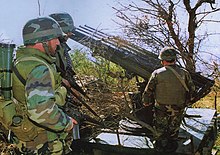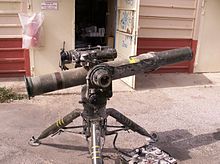Hezbollah armed strength
[5][a] A hybrid force, the group maintains "robust conventional and unconventional military capabilities",[7] and is generally considered to be the most powerful non-state actor in the world.
[17] Hezbollah's strategy against Israel uses rockets as offensive weaponry combined with light infantry and anti-armor units to defend their firing positions in southern Lebanon.
Hezbollah's tactical strengths are cover and concealment, direct fire, and preparation of fighting positions, while their weaknesses include maneuver warfare, small arms marksmanship,[18] and air defenses.
"The movement gained momentum quickly due to logistical, financial, and military support from both Syria and Iran"[10] and engaged Israel in guerrilla warfare.
The physical geography of southern Lebanon is green and hilly with deep valleys, which favored the defender and was ideal for Hezbollah's "classic" guerrilla warfare.
[33] Outgunned by the Israelis and outspent by richer Lebanese sects and political parties, Hezbollah was forced to learn fast and reappraise its tactics, strategy, and organization.
[j] In May 1988, after years of rivalry and clashes, Hezbollah waged a brief but intense war with Amal for control of Beirut's southern suburbs,[47] which at the time contained about one-quarter of Lebanon's population.
[48] After Hezbollah prevailed militarily, they soon imposed harsh Sharia law on their territory, such as banning coffee and unveiled women, and lost the hearts and minds of their people.
[43] Faced with declining public support and collapsing tourism, Hezbollah was forced to abandon its rhetoric of an Islamic republic and entered Lebanese politics in 1992.
[32][33] Later efforts by Hezbollah to create social institutions, rebuild homes destroyed by the fighting, and bring sewage, jobs, and electricity to Shiite areas were critical for building public support.
"[35] The campaign ended with the written April Understanding, which established well-understood "rules of the game" and allowed retaliation if either side crossed "red lines," particularly attacks on civilians.
[63] Hezbollah launched rockets onto populated Israeli areas and cities while using light infantry, bunkers, and anti-tank teams to defend southern Lebanon and attack the IDF.
Hezbollah focused on small self-sufficient units, based in villages, providing home-front attrition with a somewhat effective command-and-control structure and low mobility.
[57] Professor Augustus Richard Norton says that the core reasons for Hezbollah's long-term success were its resistance to Israeli occupation, institution-building, anti-western worldview, piety, pragmatism, and Iranian support.
"[96] In general, Hezbollah runs most of their own training camps, with Iran's Islamic Revolutionary Guard Corps, particularly the Quds Force, playing an integral role.
[110] To a more limited degree, Hezbollah has trained a wide range of general Islamic radicals, including fundamentalists in Tunisia, Algeria, Egypt, the Palestinian Territories, and the Gulfs states.
[32] Hezbollah's "internal security wing" cooperates with Iran's intelligence services to vet select recruits for more advanced training, with rigorous family background inspection.
[130] Arms shipments from Iran increased at this time, with the Quds Force apparently concerned that the Assad government could fall and their window to supply Hezbollah could end.
[31] Hezbollah conducted ambushes that separated Israeli infantry from armor units and inflicted more casualties per Arab fighter than any of Israel's previous opponents.
[107] Hezbollah's operational core is located south of the Litani near the Israeli border, with large numbers of short range rockets, fighters, and fortifications.
[18] Hezbollah's infrastructure is essentially composed of two parts: a network of secret bunkers in rural terrain, used by heavily trained combatants like anti-tank teams, and fortified villages defended by local residents and reservists.
[173][174] Composed mostly of fibre-optic cables run alongside existing civilian Lebanese telecommunications infrastructure, the network also contains some copper wires and standalone lines.
[224] Hezbollah's anti-aircraft guns are obsolete by decades and wholly ineffective against modern Israeli helicopters, so they are instead deployed as ground-attack artillery against Israel[35] and insurgents in Syria.
Drones and strike fighters flew at altitudes of 9,000 feet or above to keep out of range of Hezbollah's missiles, while rescue helicopters and close-air support avoided fire by flying nap-of-the-earth.
[5] Although Hezbollah's long range rockets can be based farther from the border and threaten more of Israel, they require large truck-based Transporter erector launchers that are very vulnerable to air strikes.
[31] Hezbollah has since reportedly buried their rockets in rough mountain regions of Lebanon farther from the Israeli border, which could complicate IAF efforts to find and destroy them.
While unguided rockets are terror weapons aimed at large civilian areas to inflict fear, missiles can be targeted towards specific infrastructure or locations.
[117] In 2006, Israel destroyed ten Lebanese Armed Forces radar stations along the coast, possibly because Hezbollah gained access to them to launch anti-ship missiles.
[320] In 2008, the George Bush administration assessed that Hezbollah was possibly capable of carrying out a terror attack with chemical, biological or low-grade nuclear weapons.
[324] Since 2000, Hezbollah has focused on acquiring, via public reporting and spies, a database of Israeli civilian and military infrastructure to target with rocket artillery in the event of war.







































